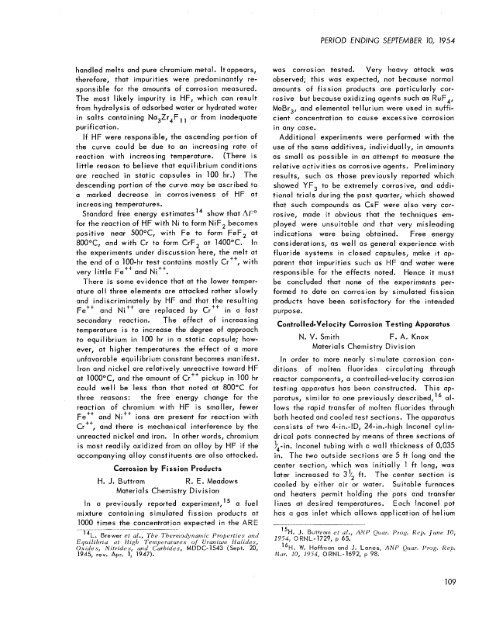ORNL-1771 - Oak Ridge National Laboratory
ORNL-1771 - Oak Ridge National Laboratory
ORNL-1771 - Oak Ridge National Laboratory
Create successful ePaper yourself
Turn your PDF publications into a flip-book with our unique Google optimized e-Paper software.
handled melts and pure chromium metal. Itappears,<br />
therefore, that impurities were predominantly re-<br />
sponsible for the amounts of corrosion measured.<br />
The most likely impurity is HF, which can result<br />
from hydrolysis of adsorbed water or hydrated water<br />
in salts containing Na3Zr4F,, or from inadequate<br />
pur if ication.<br />
If HF were responsible, the ascending portion of<br />
the curve could be due to an increasing rate of<br />
reaction with increasing temperature. (There is<br />
little reason to believe that equilibrium conditions<br />
are reached in static capsules in 100 hr.) The<br />
descending portion of the curve may be ascribed to<br />
a marked decrease in corrosiveness of HF at<br />
increasing temperatures.<br />
Standard free energy e~timates'~ show that Ai:'<br />
for the reaction of HF with Ni to form NiF, becomes<br />
positive near 5OO0C, with Fe to form FeF, at<br />
800°C, and with Cr to form CrF, at 1400°C. In<br />
the experiments under discussion here, the melt at<br />
+t<br />
the end of a 100-hr test contains mostly Cr , with<br />
very little Fe" and Ni".<br />
There is some evidence that at the lower temper-<br />
ature a11 three elements are attacked rather slowly<br />
and indiscriminately by HF and that the resulting<br />
Fe" and Ni" are replaced by Crt+ in a fast<br />
secondary reaction. The effect of increasing<br />
temperature is to increase the degree of approach<br />
to eqoilibrium in 100 hr in a static capsule; how-<br />
ever, at higher temperatures the effect of a more<br />
unfavorable equil ibrirrm constant becomes manifest.<br />
Iron and nickel are relatively unreactive toward HF<br />
at IOOO"C, and the amount of Cr++ pickup in 100 hr<br />
could well be less than that noted at 800°C for<br />
three reasons: the free energy change for the<br />
reaction of chromium with HF is smaller, fewer<br />
Fef+ and Nit' ions are present for reaction with<br />
Cr", and there is mechanical interference by the<br />
unreacted nickel and iron. In other words, chromium<br />
is most readily oxidized from an alloy by HF if the<br />
accompanying alloy constituents are also attacked.<br />
Corrosion by Fission Products<br />
H. J. Buttram R. E. Meadows<br />
Materia Is Chemis try D i v is ion<br />
In Q previously reported experiment," a fuel<br />
mixture containing simulated fission products at<br />
1000 times the concentration expected in the AWE<br />
"L. Brewer et (21." 7'?ie Tbeririodynamic Properties wtd<br />
Equilibria at Nigh Temperatures of Vrunium Ualides,<br />
Oxides, Nitrides, rrnd Curbzdrs, MDDC-1543 (Sept. 20,<br />
'1945, rev. Apr. 1, 1947).<br />
PERIOD ENDING SEPTEMBER IO, 7954<br />
was Corrosion tested. Very heavy attack was<br />
observed; this was expected, not because normal<br />
amounts of fission products are particularly cor-<br />
rosive but because oxidizing agents such as RuF4,<br />
MoBr,, and elemental tellurium were used in suffi-<br />
cient concentration to cause excessive corrosion<br />
in any case.<br />
Additional experiments were performed with the<br />
use of the same additives, individually, in amounts<br />
as small as possible in an attempt to measure the<br />
relative activities as corrosive agents. Preliminary<br />
results, such as those previously reported which<br />
showed YF, to be extremely corrosive, and addi-<br />
tional trials during the past quarter, which showed<br />
that such compounds as CsF were also very cor-<br />
rosive, made it obvious that the techniques em-<br />
ployed were unsuitable and that very misleading<br />
indications were being obtained. Free energy<br />
considerations, as well as general experience with<br />
fluoride systems in closed capsules, make it ap-<br />
parent that impurities such as HF and water were<br />
responsible for the effects noted. Hence it must<br />
be concluded that none of the experiments per-<br />
formed to date on corrosion by simulated fission<br />
products have been satisfactory for the intended<br />
purpose.<br />
Controlled-veiocity Corrosion Testing Apparatus<br />
N. '4. Smith F. A. Knox<br />
Materials Chemistry Division<br />
In order to more nearly simulate corrosion con-<br />
ditions of molten fluorides circulating through<br />
reactor components, a control led-velocity corrosion<br />
testing apparatus has been constructed. This ap-<br />
paratus, similar to one previously described,16 al-<br />
lows the rapid transfer of molten fluorides through<br />
both heated and cooled test sections. The apparatus<br />
consists of two 4-in.-ID, 24-in.-high lnconel cylin-<br />
drical pots connected by means of three sections of<br />
fh-in. inconel tubing with a WQII thickness of 0.035<br />
in, The two outside sections are 5 ft long and the<br />
center section, which was initially 3 ft long, WQS<br />
later increased to 3'/, ft, The center section is<br />
cooled by either air or water. Suitable furnaces<br />
and heaters permit holding the pots and transfer<br />
lines at desired temperatures. Each inconel pot<br />
has a gas inlet which allows application of helium<br />
109



![Review of Molten Salt Reactor Physics Calculations [Disc 2]](https://img.yumpu.com/21979492/1/190x247/review-of-molten-salt-reactor-physics-calculations-disc-2.jpg?quality=85)













